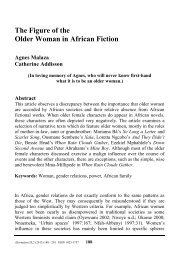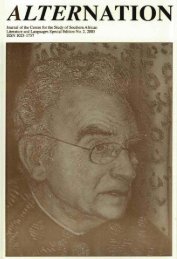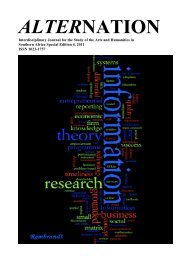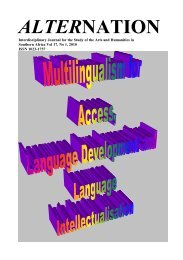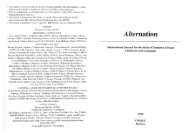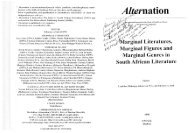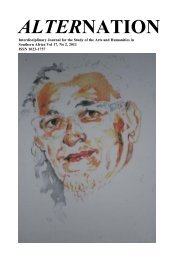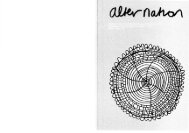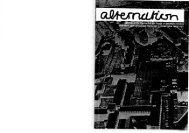Re-reading The Purloined Letter - Alternation Journal
Re-reading The Purloined Letter - Alternation Journal
Re-reading The Purloined Letter - Alternation Journal
You also want an ePaper? Increase the reach of your titles
YUMPU automatically turns print PDFs into web optimized ePapers that Google loves.
Pravina Pillay<br />
child relates to himself as if his image were that of another. This moment is<br />
the beginning of difference, which is to be fully confronted as the Other<br />
which the child confronts upon entering the Symbolic. Thus, in <strong>reading</strong> <strong>The</strong><br />
<strong>Purloined</strong> <strong>Letter</strong>, Lacan identifies a dynamic of glances which are more<br />
important for the way they act out a drama of being seen than of seeing—the<br />
power one might have only has meaning in terms of being seen to have that<br />
power by the other’s glances. <strong>The</strong> letter, with its absent content, has no<br />
identity of its own, save the role it plays in being passed around.<br />
Nevertheless, the letter lends its possessor a certain power, and this is its role<br />
as an object of desire as it passes between people: ‘<strong>The</strong> ascendancy which<br />
the Minister derives from the situation is thus not a function of the letter,<br />
but, whether he knows it or not, of the role it constitutes for him’ (Lacan in<br />
<strong>The</strong> <strong>Purloined</strong> Poe 1988:46). <strong>The</strong>re is blindness in this story, but there are<br />
also at least two forms of seeing. <strong>The</strong> letter has power because it is seen to<br />
be possessed by some characters (whose visual positions change). Lacan’s<br />
emphasis on repetition thus takes a visual turn, as he focuses ‘three<br />
moments, structuring three glances, borne by three subjects incarnated each<br />
time by different characters’ (Lacan in <strong>The</strong> <strong>Purloined</strong> Poe 1988:46). Here,<br />
there is visual exchange and recognition at each twist of the tale. Along with<br />
the power which the letter gives to its possessor, the power of the glance is<br />
also passed around—from Queen to Minister, from Minister to Dupin. <strong>The</strong><br />
gaze, and a subject position founded in it, is thus something liable to shift as<br />
the subject’s relationship to the others in its network also changes, but it is<br />
always set up in terms of the difficult gaze of the other rather than the potent<br />
look of the self. Psychoanalytic visual theory has found a very specific life in<br />
the analysis of the circulation of power in a literary text. Here, then,<br />
Williams (1995:73) points out Lacan’s old theories of the gaze which<br />
negotiate the visual dynamic represented in <strong>The</strong> <strong>Purloined</strong> <strong>Letter</strong> itself, a<br />
move closer to applied psychoanalysis than one might initially have thought<br />
Lacan would be engaging in—although he does, of course, resist a specific<br />
analysis of author-through-text: ‘Where the Freudian method is ultimately<br />
biographical’ writes E. Ann Kaplan (1990:32) ‘Lacan’s is textual’.<br />
In this seminar, Lacan also points to Poe’s treatment of the boy who<br />
always wins at odds-and-evens in the story: the boy explains that he is able<br />
to do so because he imitates (Lacan calls it ‘egomimie’) the facial expression<br />
of the other player, and, once his face has so patterned itself, he allows his<br />
384



